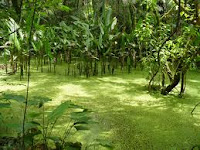The Common or lesser Duckweed is often found on garden ponds and is the bane of gardeners who don’t want to get rid of it by using chemicals. It can spread on the feet of aquatic birds and on their bills. However it does have some uses and may be a useful source of biomass and biofuel in the future. It also has some surprising health benefits.
The ancient Welsh Physicians of Myddfai had these two remedies which include it: -
“For swelling or hardness of the stomach. Boil duckweed in goat's milk, and foment it therewith frequently…
If the bowels become so constipated that they cannot be moved, take duckweed, boiling it briskly in a pot, then cast it into a pan, and fry with a quantity of blood and butter, eating it hot.”
 William Turner (c.1508-1568) often called the “Father of English Botany” had this to say of it, calling “duckis meate” for fairly obvious reasons, I suppose.
William Turner (c.1508-1568) often called the “Father of English Botany” had this to say of it, calling “duckis meate” for fairly obvious reasons, I suppose. “Duckis meate hath a cooling nature, whereof it is good to be laid to imposthumes and gatherings of the humours that run to one place, to the wildfire and great burnings, to the gouty members both alone and also with the meal of parched barley. It glueth or bindeth, or maketh fast the bowels of young chider. Galen writeth that duckis meate is of a cold and moist temperature and in manner is both cold and moist in the second degree.”
“Government and virtues. Cancer claims the herb, and the Moon will be lady of it; a word is enough to a wise man. It is effectual to help inflammations, and St. Anthony's fire, as also the gout, either applied by itself, or in a poultice with barley-meal. The distilled water by some is highly esteemed against all inward inflammations and pestilent fevers: as also to help the redness of the eyes, and swelling of the scrotum, and of the breasts before they be grown too much. The fresh herb applied to the forehead, easeth the pains of the head-ach coming of heat.”
 It has been used as a poultice as the common mallow and marsh mallow are for inflammations and swellings.
It has been used as a poultice as the common mallow and marsh mallow are for inflammations and swellings. It has often been used as poultry food and may have some value to the food industry in the future, one Turkish study published in 2010 showed that common duckweed has antioxidant, antibacterial and anti-candidal properties ( Ilhami Gűlçin et al. Turkish Journal of Biology Vol.34 pp 175-188); this study also found flavonoids such as quercetin and phenolic compounds which have antioxidant properties.
Kiosov P.A.(2001) in Comprehensive Catalogue of Medicinal Plants ( EKSMO-Press: Moscow
Duckweed has been classed in the Araceae family of plants, having formerly been in the Lemnaceae, so as such is the relative of Gloriosa superba or the Flame Lily, the Calla Lily, taro, the Elephant’s foot yam, cuckoo-pint and the sweet flag.





No comments:
Post a Comment